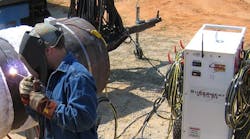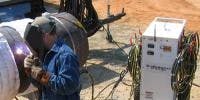By Jim Montague, executive editor
New welds are a lot like babies. They need TENDER, loving care to grow up strong and relatively free from stress.
This might not be too hard to do for a few steel alloy pipe sections or valves, but when youve got hundreds or even thousands of welds to monitor and manage, the solution is obvious. You need a boatload of babysitters.
Companies that build or help to repair oil, gas, petrochemical, or other process plants traditionally bring in dozens of technicians to oversee the many thermocouples and strip-chart recorders used to monitor pre-heating and post-weld procedures in numerous heat-affected zones (HAZs), usually for several hours each. These personnel also document that new welds meet specified hardness requirements, so theyll be durable enough to serve long term in processing heavy flows and withstand often harsh environmental conditions. Good instrumentation and control of welding, and uniform, high-quality welds can add years of service life to a pipeline.
Most post-weld procedures involve baking hydrogen out of a weld, relieving stress, or annealing it. To perform these treatments, users manually attach a ceramic-element heater to the pipe or other structure, insulate it, and apply heat via internal wires. The welder then completes the weld, which usually must be maintained at 1,400 °F for several hours, and undergo controlled cooling (Figure 2). New construction or a major renovation project can require 70-100 people to perform its heat-treating services.
Wireless Binding Ties
Power unit, computer link saves labor, frees personnel to check many more heat-treated zonesA wireless WiFi connection between SuperheatFGHs 6Wi power units and its Site-Access Management (SAM) computer system allows a technician to monitor several hundred heat-affected zones (HAZs).
Courtesy of Superheatfgh
This always had been a necessary evil in welding applications, but doing it is crucial because it can have a significant impact on weld quality, project cost and logistics, and on-site safety and security, says Gary Lewis, business development director at SuperheatFGH Canada, Kincardine, Ontario. One power supply can run six to 12 heaters, but the traditional process was so labor-intensive because we needed one operator to read the recorder for each power supply, and we could only respond manually to data outside parameters. To help it and its clients reduce some of these traditionally high labor costs, SuperheatFGH recently developed and implemented a wireless solution between its 6Wi 460 V, six-HAZ power-units and Site-Access Management (SAM) computing system. This WiFi link allows a technician, who used to monitor only six to12 weld zones, to now oversee and run up to 100 power units, or a total of 600 zones. Lewis says this allows Superheat to run a welding project with 70% fewer staff, which means a site that used to need 100 technicians now needs only 30 or fewer. The level of these labor savings even enables more users to self-perform more of their own welding projects, so Superheat trains them to use its technology.
Superheat acquired U.K.-based FGHs temperature control and instrumentation technology when the company was founded in 2000.
Assisting Aecon at Suncor
Aecon Group Inc. recenty performed a three-month, $3 million chrome-steel pipe installation and distillation tower rebuild project at Suncors new oil-sands processing plant complex in Calgary, Alberta. The project required Aecon to use hundreds of heaters, and so it enlisted Superheat to help monitor them. Aecons facilities include pipe fabrication, refinery module assembly, and site construction services. Heat treating (HT) and stress relief of alloy-steel components and piping play a significant role in all three jobs.
When it comes to pipe and components fabricated from chromium-molybdenum-vanadium (Cr-Mo-V) alloyed steels, such as P91 and P92 grades, as well as heavier, thicker carbon steels, heat treating is mandated, says Diego Carducci, construction operations manager for Aecons western operations. Codes specify the HT cycles during and after welding to yield the proper strength and ductility and to markedly reduce the chance of weld cracking. This is where we use SuperheatFGHs services. He adds that governing authorities wouldnt allow Aecon to perform such welds without proper HT. In performing a welded joint for chrome, for example, the material has to be stress-relieved after welding and receive post-weld heat-treating (PWHT). Non-destructive testing procedures are carried out on these alloy steels. Weld hardness is checked by using either Brinnell or Vickers scales, and final post-weld hardness must be certified to be within a certain range, depending on the welding procedure.
Birth of a weld
A welder completes the joining of two pipe sections, which typically must be maintained at 1,400 °F for several hours, and undergo controlled cooling to ensure required hardness and long-term durability.
Courtesy of Superheatfgh
Suncors rebuild involved demolishing piping, tearing down the vessel, replacing piping, and repairing and reinstalling the vessel that separates different grades of crude oil in the refining process. The job also included a plant maintenance shutdown to take care of systems and equipment needing repair. Both the rebuild and the maintenance required a significant amount of HT because of the chrome-alloy steels selected by its engineers and consultants had to achieve increased service life and operating pressures that these steels enable. Chromium-alloyed steels typically are used because they retain their mechanical properties better than carbon-based steels in high-temperature environments, are thinner and lighter in weight, and less expensive to buy and fabricate.It was a fairly intense schedule, adds Carducci. The tower had to be rebuilt in eight months, though this kind of task usually takes at least twice as long. We had to work 24/7. Superheats wireless controlled HT technology worked seamlessly.
The Way To Wireless
To implement its wireless solution, Superheat still attaches one or multiple Type K thermocouples (T/C) to each section being welded, and hardwires the signals back to their 6Wi power unit. This HT unit checks temperature data for accuracy four times a second and controls the application of power accordingly. However, now the 6Wi units are connected to SAM via Superheats temporary, as needed, project-specific WiFi transceivers and antennas that make up its dedicated, proprietary wireless local network (WLAN) and wide area network (WAN) (Figure 1).
SAM allows users to monitor the performance of every 6Wis at a project in one centralized location, which requires far fewer on-site technicians to passively watch chart recorders. Superheats secure, on-site WLAN uses a spread-spectrum, channel-hopping algorithm that prevents interference with any other wireless network. Lewis says the WLANs 902-928 MHz unlicensed bandwidth provides security and performance despite the presence of any buildings or plant units, and reliably covers all locations within three square miles at a typical plant site. Binary-coded data are sent over the WLAN to SAM every 60 seconds.
SAM then sends its collective data via an Internet connection to Superheats Quality Management Center (QMC) in Kincardine. Likewise, all this telemetry and power data also is available to users in real-time via the Internet, cell phones, and PDAs by using Superheats SmartView software. Lewis says readily available data makes end-users less dependent on third-party contractors. For instance, this allows users to optimize their schedules, and deploy welders more effectively to get more work done. QMC subsequently generates drawings that Superheat can give back to clients to show its tasks have been completed and performed according to required specifications. This documentation traditionally is done on paper, so were also saving a ton of time and money by doing it digitally now.
For example, Carducci says the carefully controlled stepping up, holding, and stepping down of heat in HT processes also is duly recorded to form part of the QA document package that Aecon turns over for Suncor to accept each weld. Because of the nature of the process and the amount of control required, I was doubtful at first that a wireless solution actually would work in a rough industrial environment, he says. Sometimes our cell phones dont work in those conditions, let alone controlling temperature on a weld! However, as we progressed and the temperature data came in, everything was documented and accepted by our client.
Each 6Wi now is equipped with downloaded software detailing the profile specs and welding procedure for each joint. This gives SAM access to telemetry we can use to identify and respond to any deviation from prescribed specification, says Lewis. We even can send signals back to the 6Wis to control HAZ temperatures, turn heaters on and off, and allow 6Wis to run independently.
Likewise, SAM can update and inform site managers about messages between QMC, SAM and the 6Wis, order emergency shutdowns, or keep operating if personnel have to evacuate the area. Returning signals also can activate a Smart Light at each HAZ to let welders and technicians know if applied heat is within parameters.
Labor Savings
Carducci says Aecon had 700 employees on the Suncor job, while Superheat used about 30 peoplefar fewer than needed by traditional technology.
Ralph Falle, Superheats operations superintendent, adds that day and night manpower needed for PWHT at the Suncor project consisted of 11 technicians wrapping piping jobs, including two technicians monitoring two HT units locally, and one technician in the control room. This same job with this much equipment would probably take a traditional HT company an additional six technicians to monitor chart recorders, says Falle. At $60 per hour for six HT technicians working 24/7 over three months, Falle calculates that wireless HT saved the Suncor project about $800,000.
The cost of the wireless-managed project to our client was around 23% less than it would have been with traditional HT, says Falle. Because we can transfer data wirelessly from machines to one remote location, we dont have non-productive people. We can go to a job location, wrap up that work, and move on to the next location to perform other duties. No one stands still.

Leaders relevant to this article:





